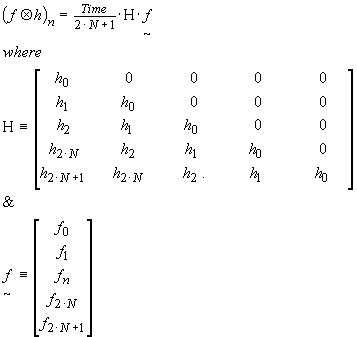
![]()
Notes
Let us define the function
![]() to
equal the convolution between two functions
to
equal the convolution between two functions
![]() and
and
![]() expressed
as
expressed
as
![]()
I will sometimes use subscripts to
represent variables where this is convenient and clear. This convolution is
defined as the integral

where t represents a “dummy variable” for integration. It might be thought that this convolution could also be expressed in discrete variable as

However beware! Most computational software dislikes negative indices and requires that each vector index starts at n = 0. To accommodate this offset we need to add a small modification e.g.


Alternatively

Interestingly the discrete convolution can also be interpreted as a matrix-vector operation i.e.

If the matrix H is invertible, then we should be able to predict f from g (where g could be thought of as the output from a system H and f is the input)
![]()
Convolution reveals a number of surprising consequences - despite its seemingly simple but obscure proposition; so let's use this proposition to predict a few outcomes.
![]()
© Ian Scott 2009